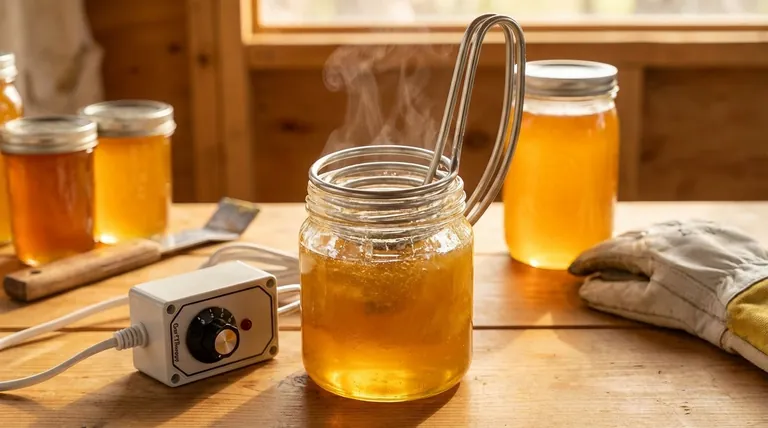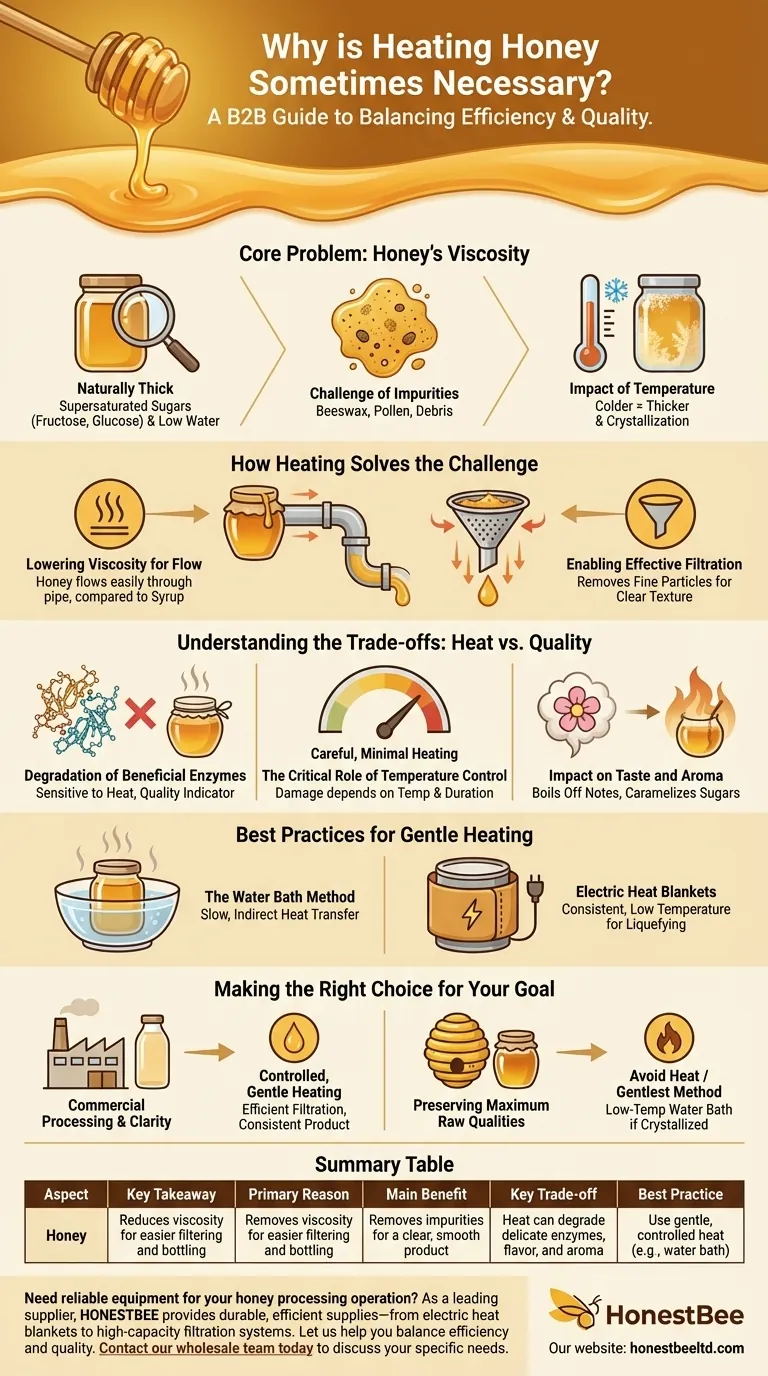At its core, heating honey is a practical processing step performed primarily to reduce its viscosity, or thickness. This makes the honey less resistant to flowing, which is necessary for effectively filtering out impurities like wax particles and for easier bottling.
The decision to heat honey is a trade-off between processing efficiency and the preservation of its natural qualities. While necessary for filtering on a larger scale, any application of heat risks degrading the delicate enzymes and flavors that define high-quality, raw honey.

The Core Problem: Honey's Viscosity
Why Honey is Naturally Thick
Honey is a supersaturated solution of sugars, primarily fructose and glucose, with a very low water content. This composition makes it naturally thick and viscous, a state that is often desirable but presents challenges in processing.
The Challenge of Impurities
During extraction from the comb, honey can become mixed with small particles. These often include bits of beeswax, pollen, and other hive debris that need to be removed to achieve the clear, smooth texture consumers expect.
The Impact of Temperature
Honey's viscosity is highly dependent on temperature. In colder environments, it thickens considerably and can even crystallize, making it nearly impossible to pour or filter without intervention.
How Heating Solves the Processing Challenge
Lowering Viscosity for Flow
Applying gentle heat is the most effective way to temporarily lower honey's viscosity. As the honey warms, it flows much more easily, similar to how syrup becomes runnier when heated.
Enabling Effective Filtration
This improved flow is crucial for the filtration process. By passing the warmed, less viscous honey through filters, processors can efficiently remove fine particles that would otherwise remain suspended in the thick, cool liquid.
Understanding the Trade-offs: Heat vs. Quality
The Degradation of Beneficial Enzymes
The most significant drawback of heating is the destruction of natural enzymes. Raw honey contains enzymes like diastase and invertase, which are sensitive to heat and are considered key indicators of its quality and beneficial properties.
Impact on Taste and Aroma
Overheating can also cause a deterioration in taste and aroma. The delicate floral notes can be boiled off, and the sugars can begin to caramelize, fundamentally altering the honey's flavor profile.
The Critical Role of Temperature Control
The damage done by heating is not an all-or-nothing event. It is directly related to the temperature and duration of the heat applied. Careful, minimal heating does far less damage than rapid, high-temperature methods.
Best Practices for Gentle Heating
The Water Bath Method
A common and effective method for gentle warming is the water bath. The honey container is placed in a larger vessel of warm water, allowing for slow, indirect heat transfer that warms the honey without creating hot spots that cause scorching.
Electric Heat Blankets
For beekeepers and processors, electric heat blankets or cabinet heaters are often used. These are designed to wrap around a container and maintain a consistent, low temperature over a longer period, making them ideal for liquefying crystallized honey in cold months.
Making the Right Choice for Your Goal
- If your primary focus is commercial processing and clarity: Controlled, gentle heating is a standard and necessary step to ensure efficient filtration and a consistent, clear product.
- If your primary focus is preserving maximum raw qualities: Avoid heat whenever possible. If your honey crystallizes, use the gentlest method available, such as a low-temperature water bath, to return it to a liquid state.
Ultimately, understanding the purpose of heating empowers you to make informed choices based on whether your goal is perfect clarity or the preservation of honey in its most natural state.
Summary Table:
| Aspect | Key Takeaway |
|---|---|
| Primary Reason | Reduces viscosity for easier filtering and bottling. |
| Main Benefit | Removes impurities like wax for a clear, smooth product. |
| Key Trade-off | Heat can degrade delicate enzymes, flavor, and aroma. |
| Best Practice | Use gentle, controlled heat (e.g., water bath) to minimize quality loss. |
Need reliable equipment for your honey processing operation?
As a leading supplier to commercial apiaries and distributors, HONESTBEE provides the durable, efficient beekeeping supplies you need—from electric heat blankets for gentle warming to high-capacity filtration systems. Let us help you balance processing efficiency with product quality.
Contact our wholesale team today to discuss your specific needs and volume pricing.
Visual Guide

Related Products
- Professional Thermostatic Conical Honey Melter
- Pneumatic Double Nozzle Honey Filling Bottling Packaging Machine
- Honey Concentrating Vacuum Heating Thickening Machine Dehumidifier for Honey
- 8-Frame Electric Self-Reversing Honey Extractor Spinner for Commercial Honey Extraction Equipment
- Economy Small Scale Honey Dryer Dehumidifier Thickening Machine
People Also Ask
- What is melter honey used for? A Low-Cost Ingredient for Bakers and Brewers
- How does the Bee Blanket help maintain honey quality? Preserve Enzymes with Gentle Hive-Mimicking Heat
- What are the negative effects of overheating honey? Preserve Your Honey's Natural Quality
- How to permanently decrystallize honey? Embrace Its Natural State for Maximum Quality
- Is it safe to heat crystallized honey? Restore Your Honey's Liquid State Safely



















